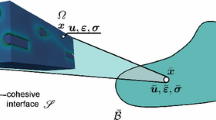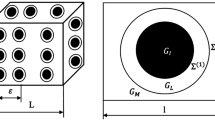Abstract
In order to simulate the nonlinear behaviour of elastomer composite materials, we use a homogenization technique which induces nonlinear problems. This paper presents a non-incremental solving method which allows the reduction of computational costs. In this paper the equivalence between the proposed solving method and a Newton-type method is proved, which allows us to prove the convergence under realistic assumptions. Numerical results on a composite illustrate the performances of this method.
Similar content being viewed by others
References
H. Alexander, A constitutive relation for rubber-like materials, Internat. J. Engrg. Sci. 6 (1968) 549-563.
E.M. Arruda and M.C. Boyce, A three-dimensional constitutive model for the large stretch behavior of rubber elastic materials, J. Mech. Phys. Solids 41 (1993) 389–412.
J. Ball, Convexity conditions and existence theorems in non linear elasticity, Arch. Rational Mech. Anal. 63 (1977) 337–403.
A. Bensoussan, J.L. Lions and G. Papanicolaou, Asymptotic Analysis for Periodic Structures, Studies in Applied Mathematics and Its Applications, Vol. 5 (North-Holland, Amsterdam, 1978).
M. Bernadou, P.G. Ciarlet and J. Hu, Sur la convergence des méthodes incrémentales en élasticité non-linéaire tridimensionnelle, C. R. Acad. Sci. Paris Sér. I 295 (1982) 639–642.
M. Brieu, Homogénéisation et endommagement de composites élastomères par techniques de calcul parallèle, Thèse de Doctorat, Ecole Normale Supérieure de Cachan (1999).
M. Brieu and F. Devries, Homogénéisation de composites élastomères. Méthode et algorithme, C. R. Acad. Sci. Paris Sér. II 326 (1998) 379–384.
M. Brieu, F. Devries and J. Erhel, Algorithme parallèle non incrémental pour la simulation de l'évolution d'endommagements en milieux hyper élastiques, Calculateurs Parallèles Réseaux Systèmes Réparties 13(1) (2001) 83–106.
P.G. Ciarlet, The Finite Element Method for Elliptic Problem (North-Holland, Amsterdam, 1978).
P.G. Ciarlet and G. Geymonat, Sur les lois de comportement en élasticité non linéaire compressible, C. R. Acad. Sci. Paris Sér. II 295 (1982) 423–426.
J.Y. Cognard, Une nouvelle approche des problèmes de plasticité et de viscoplasticité, La M.A.G.I.T., Thèse de Doctorat, Université Paris VI (1989).
J.E. Denis and R.B. Schnabel, Numerical Methods for Unconstrained and Nonlinear Equations, Computational Mathematics (Prentice-Hall, Englewood Cliffs, NJ, 1983).
F. Devries, Calcul du comportement homogénéisé de composites hyperélastiques, Rev. Composites Matériaux Avancés 6(2) (1996).
F. Devries, Homogenization of elastomer matrix composites. Method and validation, Composites Engrg. Part B 29(6) (1998) 753–762.
G. Dhatt and G. Touzot, Une Présentation de la Méthode des Éléments Finis (Les presses de l'Université de Laval, Québec, 1981).
H. Dumontet, Homogénéisation des matériaux stratifiés de type élastique linéaire, non linéaire, viscoplastique, Thèse de 3ème cycle, Université Paris VI (1983).
G. Duvaut, Mécaniques des Milieux Continus (Masson, Paris, 1990).
G. Geymonat, S. Müller and N. Triantafyllidis, Homogenization of nonlinearly elastic materials, microscopic bifurcations and macroscopic loss of rank-one convexity, Arch. Rational Mech. Anal. 122 (1993) 231–290.
P. Ladeveze, Mécanique non Linéaire des Structures, Etudes en Mécaniques des Matériaux et des Structures (Hermés, 1996).
J. Lambert-Diani and C. Rey, Elaboration de nouvelles lois de comportement pour les élastomères, C. R. Acad. Sci. Paris (1998).
F. Léné, Contribution à l'étude des matériaux composites et de leurs endommagements, Thèse de Doctorat, Université Pierre et Marie Curie (1991).
S. Müller, Homogenization of nonconvex integral functionnals and cellular elastic materials, Arch. Rational Mech. Anal. 99 (1987) 189–212.
R.S. Rivlin, Large elastic deformation of isotropic materials I. fundamental concepts, Philos. Trans. Roy. Soc. London Ser. A 240 (1948) 459–490.
D.R.S. Talbot and J.R. Willis, Bounds and self-consistent estimates for the overall properties of nonlinear composites, IMA J. Appl. Math. 39 (1987) 215–240.
N. Triantafyllidis and B.N. Maker, On the comparison between microscopic instabillity mechanisms in a class of fiber reinforced composites, ASME J. Appl. Mech. 52 (1985) 794–800.
J.R. Willis, Variational and related methods for the overall properties of composites, Adv. in Appl. Mech. 21 (1981) 1–78.
Author information
Authors and Affiliations
Rights and permissions
About this article
Cite this article
Brieu, M., Erhel, J. On the Convergence of a Non-incremental Homogenization Method for Nonlinear Elastic Composite Materials. Numerical Algorithms 32, 141–161 (2003). https://doi.org/10.1023/A:1024019501434
Issue Date:
DOI: https://doi.org/10.1023/A:1024019501434




